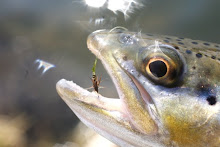This story must have been written from a trip taken in May, as it hasn't rained much in the five weeks in the U.P. For those unfamiliar, it is not the wild unbroken wilderness people want it to be, and as this article attests, the natives are skilled at taking fish from the water with spinners, nightcrawlers and set lines. This is about the average experience up there though. Mostly few and smallish fish from the Escanaba watershed.
The below is posted from the Green Bay Gazette.ISHPEMING, Mich. — "All's well that ends well" ... so the saying goes.
Advertisement
"… if you can forget the misfortune it took to reach the finish," I might add, speaking from experience after a recent routine canoe trip got off to a rough start. Then things got rougher.
Bob LaFreniere and I had scheduled a trout fishing float down the Escanaba River in Michigan's rugged Upper Peninsula only to waken on the appointed day under soggy skies amid cool temperatures in the mid-50s.
"A little rain never hurt anybody," said LaFreniere, a native Yooper. "Grab your rainwear and let's get on the road."
Forty minutes later, our two-vehicle caravan pulled up to a backwoods bridge and dropped off Bob's pickup. Ten minutes and a roundabout six road miles later, we offloaded a 17-foot aluminum canoe at the designated starting point, a bridge about three water miles upstream.
Neither of us had experience with this segment of the river and had no idea what to expect, though we had heard trout fishing could be worthwhile at times.
The plan was to drift and paddle downstream to the truck, fishing and taking in scenery along the way.
No problem there. We managed to land a handful of brook trout, including a couple that broached the 10-inch mark, but the wilderness setting was too frequently interrupted by rustic cottages.
"These are all deer hunting cabins," LaFreniere assured. "The owners don't fish."
Some of them obviously had an interest in the water, however, as small docks emerged from several shorelines. A well-worn spinning rod sprouted from one of the appendages, the line still holding to a weed-encrusted bobber stuttering in the current.
The pulsating drizzle was an annoyance, not a hindrance, and the un-summerlike temperature coupled with a gusty wind removed the need for mosquito repellent.
Bob preferred fishing with nightcrawlers. I started fishing with worms, then switched to a spinner. Both rigs were effective.
A five-hour float brought us to the takeout point. When the canoe touched bottom, I made a move to exit. Veteran legs — after spending too much time in the cramped front seat — weren't up to the task.
My foot slipped on a rock. I tilted backward, lost balance and kersplunken ... I tipped the canoe.
After a few sobering seconds of soaking up river flow that eagerly ebbed over the top of my waders, I turned to find a somber Bob pinned in waist-deep water and contents of the canoe floating around him in disarray.
"You know my cell phone is shot," he quickly pointed out.
A dunking is death to a cell phone but considerably less hazardous to rods, reels, creels, boots, bait, clothing, cushions and lunch.
We gathered the drenched booty and hauled the canoe well on shore.
As Bob silently approached the waiting truck with a load of dripping gear, he slowly turned and said, "Do you want to know the rest? ... I left the keys to the truck in the Jeep back at the other landing."
There we stood, looking at one another — Glum and Glummer.
"Someone has to eventually drive by this landing," Bob finally said. "We'll ask them to bring us to the Jeep."
"This is a gravel and dirt road that doesn't go anywhere except to deer hunting camps," I pointed out. "It could be an hour or it could be days before someone comes along. You stay here and I'll start walking the road back out."
Approximately 45 minutes into a lumbering trek in semi-soggy waders, a rumbling pickup truck piloted by three young men stopped and offered to be my taxi. I eagerly clambered into the back of the truck bed, gingerly stepped around a pile of jagged, rusted, scrap metal and found a sprawling spare tire for a seat.
Heaven never looked so good.
After reconnecting with Bob, we made a beeline for Ishpeming, intending to replace the deep-sixed cell phone, which contained numbers vital to his business in Ohio.
No luck in Ishpeming. Ditto for nearby Negaunee. Finally, in Marquette, we located Bob's cell phone carrier — and an angel in the form of a customer service representative. With an ever-present smile, she patiently listened to our tale and helped Bob select a new phone — one with more features and a larger keypad than his defunct unit.
After processing the purchase, she beamed and said, "This is your lucky day. We're having a special sale on that model. After a mail-in rebate, it will cost you nothing."
Then she downloaded all information from computerized chips in the old phone into the new one. The major loss turned out to be three hours of phone service.
As we walked out the door, Bob was smiling again.
"You know," he said, "I never thought I'd be glad you dunked me."
Believe me, I just love a happy ending.
— Jim Lee is an outdoors writer for Gannett Wisconsin Media. E-mail him at jlee77@earthlink.net.

































































